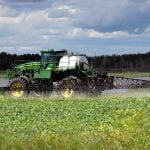Canada’s farm debt rose by more than $4 billion last year despite record commodity prices and farm receipts, says Statistics Canada.
It was a six percent increase from the previous year.
The $69.6 billion debt marked the 19th consecutive year that farm debt has increased in Canada, almost tripling since the last year of debt decline in 1992.
Total farm debt has increased 25 percent since 2007.
Retired University of Guelph agricultural economist George Brinkman has argued that Canada’s farm debt level is a competitive disadvantage because per capita farm debt is much lower in the United States.
Read Also

No special crop fireworks expected
farmers should not expect fireworks in the special crops market due to ample supplies.
He has called Canada’s farm debt level a “ticking time bomb.”
Debt servicing charges of more than $2.3 billion were one of the largest farm expenses off the farm bottom line last year.
Alberta, with a $1.1 billion debt increase last year and more than 22 percent of the national debt, is second only to Ontario in debt owed at $15.7 billion.
Meanwhile, national farm asset values including land and buildings, livestock and machinery but excluding quota, increased by $18 billion last year to $326 billion.
Agricultural analysts say the farm debt increase, prompted in part by years of low interest rates, comes as farmers buy high-priced land to expand and expensive dairy and poultry quota and machinery to accommodate larger operations.
It is a sign of optimism and investment in the industry, but it also leaves farmers vulnerable if interest rates rise because debt is serviced from cash flow rather than rising asset values.
“I would say it shows farmers making long-term investments to position themselves for future competitiveness, and that is positive,” said Canadian Federation of Agriculture president Ron Bonnett.
“However, one of the things we have to be cautious of is whether the debt load is sustained only by low interest rates. If there was a spike, farmers would have to react, and could they?”
Bonnett, who lived through the double-digit interest rates of the 1980s, said a trap farmers entered then was signing floating interest rate agreements that saw their debt servicing costs escalate.
“There are better instruments these days, but it is something farmers have to keep in mind as a financial management tool,” Bonnett said.
Richard Gray, acting head of the University of Saskatchewan’s bio-resource policy, business and economics department, said many farmers benefiting from high commodity prices could accommodate higher debt and even some increase in interest rates.
However, some farmers are heavily leveraged.
“As it was in the 1980s, there is a distributional issue,” said Gray, days after finishing seeding at his Saskatchewan grain farm.
“A lot of that debt is held by farmers who are highly leveraged and they are good managers but also vulnerable.”
At the George Morris Centre in Guelph, Ont., senior research analyst Larry Martin said the ever-rising farm debt level does not mean “the sky is falling.”
“But are we more vulnerable to risk? Absolutely, we are more susceptible, for sure,” he said.
Martin argued that an interest rate increase of one or two percent would not make much difference.
“A four or five percent increase would have a huge impact.”
One factor of the latest farm debt numbers is that the share held by chartered banks, while still the largest, has been falling and federal government agencies, including Farm Credit Canada, have been claiming a larger share.
Credit unions remain a distant third in farm debt holding with less than 16 percent.
According to Statistics Canada data, farm debt since 2007 has increased by $14 billion while the number of census farms has decreased by more than 10 percent.














